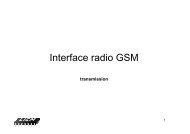Dependable Memory - Laboratoire Interface Capteurs ...
Dependable Memory - Laboratoire Interface Capteurs ...
Dependable Memory - Laboratoire Interface Capteurs ...
Create successful ePaper yourself
Turn your PDF publications into a flip-book with our unique Google optimized e-Paper software.
1.5. MEANS 25<br />
Extent<br />
A permanent fault if occurs once, persists until the end of the execution. Even a single perma-<br />
nent fault can create multiple errors until being repaired. Such errors are called hard errors.<br />
• Intermittent: It is a fault which appears, disappears, and reappears repeatedly within a very<br />
short period. An intermittent fault can occur repeatedly but not continuously for a long time in<br />
a device.<br />
The errors in modern computers may result due to permanent, intermediate and transient faults.<br />
However, transient faults occur considerably more often than permanent ones, and are much<br />
harder to detect [RS09]. The ratios of transient-to-permanent faults can vary between 2:1,<br />
100:1 or higher. This ratio is continuously increasing [Kop04].<br />
The fault extent specifies whether the fault is localized to a given hardware or software module or<br />
whether it globally affects the hardware, the software, or both.<br />
Value<br />
The fault value can either be determinate or indeterminate. A determinate fault is one whose<br />
status remain unchanged throughout the time unless there is an external action upon it, whereas an<br />
indeterminate fault is one whose status at some time t may be different from its status at another time.<br />
1.5 Means<br />
There are four means to attain dependability: fault prevention, fault tolerance, fault removal and<br />
fault forecasting. Fault prevention and fault tolerance aim to provide the ability to deliver a service<br />
that can be trusted, while fault removal and fault forecasting aim to reach confidence in that ability by<br />
justifying that the functional and the dependability and security specifications are adequate and that<br />
the system is likely to meet them [LRL04, LB07].<br />
1.5.1 Fault Prevention<br />
Fault prevention is the ability to avoid the occurrence or introduction of the faults. Fault prevention<br />
includes any technique that attempts to prevent the occurrence of faults. It can include design reviews,<br />
component screening, testing and other quality control methods.<br />
1.5.2 Fault Removal<br />
Fault removal is the ability to lessen the number and severity of faults. It can be conducted<br />
during corrective or preventive maintenance processes. Corrective maintenance aims to remove faults



